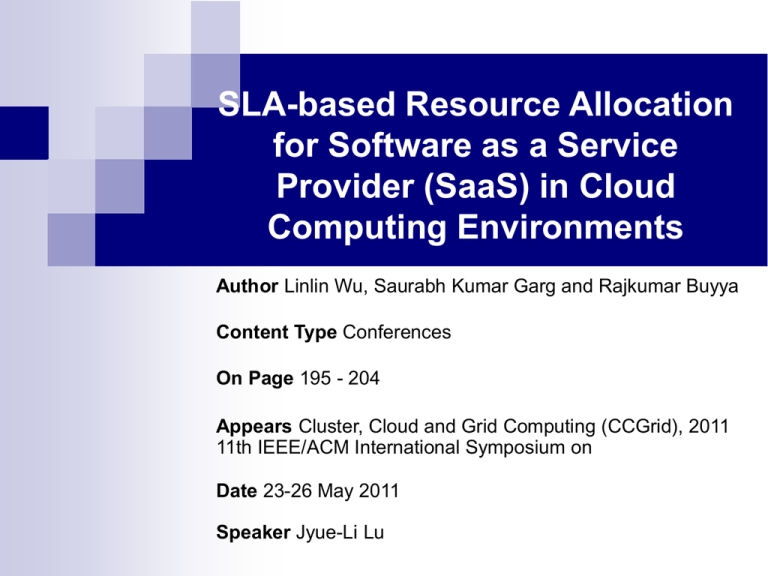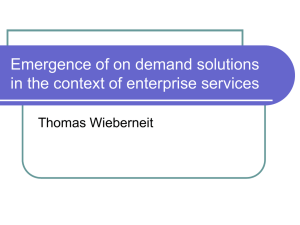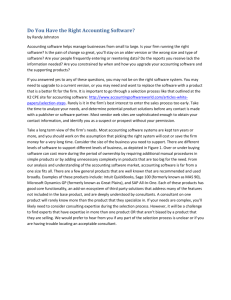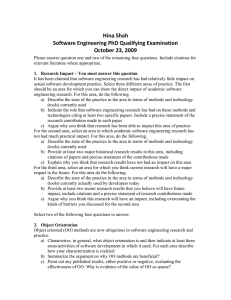SLA-based Resource Allocation for Software as a Service Provider (SaaS) in Cloud
advertisement

SLA-based Resource Allocation for Software as a Service Provider (SaaS) in Cloud Computing Environments Author Linlin Wu, Saurabh Kumar Garg and Rajkumar Buyya Content Type Conferences On Page 195 - 204 Appears Cluster, Cloud and Grid Computing (CCGrid), 2011 11th IEEE/ACM International Symposium on Date 23-26 May 2011 Speaker Jyue-Li Lu Abstract Cloud computing has been considered as a solution for solving enterprise application distribution and configuration challenges in the traditional software sales model. However, in order to deliver hosted services to customers, SaaS companies have to either maintain their own hardware or rent it from infrastructure providers. Abstract In order to minimize the cost of resources, it is also important to satisfy a minimum service level to customers. Therefore, this paper proposes resource allocation algorithms for SaaS providers who want to minimize infrastructure cost and SLA violations. INTRODUCTION Traditionally the shrink-wrapped software sales model dominated the market. Customers need technical expertise and high initial investment for buying software. They also need to pay for upgrades as annual maintenance fee. INTRODUCTION The software services are provisioned on a pay-asyou-go basis to overcome the limitation of the traditional software sales model. SaaS providers are looking into solutions that minimize the overall infrastructure cost without adversely affecting the customers. Hence, the focus of this paper is on exploring policies to minimize the required infrastructure to satisfy customer demand in the context of SaaS providers offering hosted software services. INTRODUCTION To satisfy customer’s request in order to enlarge market share and minimize cost, the following questions have to be addressed: How to manage the dynamic change of customer requests? How to map customer requirements to infrastructure level parameters? How to deal with the infrastructure level heterogeneity? INTRODUCTION The key contributions of this paper are as follows: It defines SLA with customers based on QoS parameters. It describes the mapping strategy by interpreting customer request requirements to infrastructure level parameters. It designs and implements scheduling mechanisms to maximize an SaaS provider’s profit by reducing the infrastructure cost and minimizing SLA violations. RELATED WORK In summary, this paper is unique in the following aspects: It manages the customer satisfaction level based on customer QoS requirements in minimizing the SLA violation and cost to increase the revenue, which is absent from most previous works in Cloud computing environments. The utility function is time-varying by considering dynamic VM deployment time (aka initiation time). SYSTEM MODEL Actors SaaS Providers Customers Mapping Strategy: Mapping of customer QoS requirements to resources Mathematical Models SYSTEM MODEL:Actors(SaaS Providers) SaaS providers lease enterprise software as hosted services to customers. Customers can request an upgrade of services dynamically at any time in practice. Thus a SaaS provider has to handle these requests intelligently in line with the requirements as set out in the SLA. SYSTEM MODEL:Actors(SaaS Providers) The SLA properties include SaaS provider predefined parameters and the customer specified QoS parameters. Request Type (reqType) First time rent Upgrade service ‘add account’ ‘upgrade product’ Product Type (proType) Standard Professional Enterprise SYSTEM MODEL:Actors(SaaS Providers) Account Type (accType) Group(m) Team(2m) Department(5m) Contract Length (conLen) Number of Accounts (accNum) Number of Records (recNum) Response Time (respTime) It represents the elapsed time between the end of a demand on a software service and the beginning of a service. respTime(ftr) respTime(upSev,addAcc) respTime(upSev,upPro) SYSTEM MODEL:Actors(SaaS Providers) The platform layer of a SaaS provider uses VM images to create instances according to the mapping decision. Therefore, it is important to identify the following properties for the resource allocation mechanisms to assure the SLA is adequately drafted: VM types (l) large VM equals to two medium VMs or four small VMs Service Initiation Time (iniTimeSev) VM Price (PriVM) Data Transfer Time (dataTrafT) Data Transfer Speed (dataTrafSpeed) SYSTEM MODEL:Actors(Customers) When a customer agrees with pre-defined SLA properties, a request for an enterprise application is sent to the SaaS provider’s application layer with the customer’s QoS requirements. SYSTEM MODEL:Mapping Strategy SYSTEM MODEL:Mathematical Models SYSTEM MODEL:Mathematical Models SYSTEM MODEL:Mathematical Models ALOGORITHM Base Algorithm: Maximizing the profit by minimizing the number of SLA violations (ProfminVio) Algorithm 1: ProfminVmMaxAvaiSpace Algorithm 2 : ProfminVmMinAvaiSpace ALOGORITHM - Base Algorithm This algorithm reduces the number of violations by using a new VM for each company to guarantee the response time. However, it is costly because a large number of VMs are initiated. CONCLUSION AND FUTURE WORK This paper focused on scheduling customer requests for SaaS providers with the explicit aim of cost minimization with dynamic demands handling. Thus, we implemented three cost driven algorithms which considered various QoS parameters from both the customers’ and the SaaS providers’ perspective. Simulation results show that on average, the ProfminVMminAvaiSpace algorithm optimized cost savings better when compared to the other proposed algorithms.




